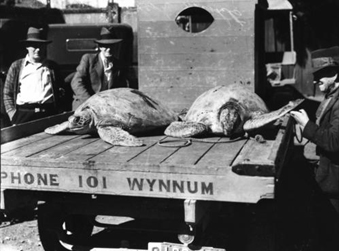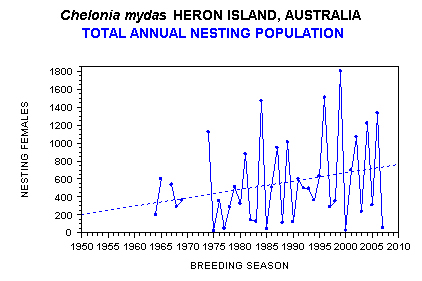Green turtle

Common name: green turtle
Scientific name: Chelonia mydas
Family: Cheloniidae
Description
Green turtles are olive-green above, usually variegated with brown, reddish-brown and black. They are whitish or cream below. The green turtle is named for the greenish colour of its fat, caused by its diet of seagrass.
They have a smooth, high domed carapace (shell) with non-overlapping scutes. The carapace of a mature green turtle can grow to a length of more than 1m and weigh on average 150kg.
Hatchlings are shiny black above and white below, with white margins around the carapace and flippers. The average carapace length is about 5cm and each hatchling can weigh approximately 25g.
Habitat and distribution
Green turtles occur in coral reefs that are rich in seaweeds, and in coastal seagrass pastures in tropical and subtropical areas worldwide.
In Australia there are nine separate genetic stocks for the green turtle, and three of these occur in Queensland. The entire Great Barrier Reef area is an important feeding area for turtles which nest locally, as well as for those which nest in other regions and countries.
Green turtles that nest on the Australian coast migrate from numerous feeding grounds dispersed through Indonesia, Papua New Guinea, Solomon Islands, Vanuatu, Fiji and New Caledonia as well as from Queensland, Northern Territory and Western Australia. They make long migrations between feeding grounds and nesting beaches. Some of the longest known migrations made by turtles that nest in the southern Great Barrier Reef have exceeded 2600km but the average migration is about 400km.
Nesting beaches occur on offshore islands, cays and also along some sections of the mainland coast. In Queensland, the southern Great Barrier Reef has 13 major rookeries including North West, Wreck, Hoskyn and Heron Islands. The northern Great Barrier Reef has five major rookeries including Raine Island and nearby cays, and Bramble Cay in the Torres Strait. The south-eastern Gulf of Carpentaria has three major rookeries at Bountiful, Pisonia and Rocky Islands.
The green turtle’s foraging habitat occurs along shallow coastal areas of Queensland, among the reefs of the Great Barrier Reef and in the Gulf of Carpentaria.
Life history and behaviour
In southern Queensland, nesting occurs between late November and January. It takes a female green turtle 30-40 years to reach maturity. Most females will return to the same nesting area between seasons and to the same beach within a nesting season.
In general, a female green turtle lays about 115 eggs per clutch that are round, roughly the size of ping-pong balls. Each nesting season she returns to the beach to nest an average of five times at fortnightly intervals. The eggs require temperatures in the range of 23–33°C throughout incubation. As with other species of marine turtles, the sex of the hatchlings is determined by nest temperature. Males result from cooler temperatures and females from warmer temperatures.
Adult green turtles feed mostly on seaweeds, seagrass (e.g. Halophila ovata) and mangrove fruits, although immature green turtles are carnivorous.
Threatening processes
Green turtle populations are threatened by climate change impacts, marine debris entanglement, e.g. drowning in crab pots and chemical and terrestrial discharge. Other threats include unsustainable hunting of green turtles in the Gulf of Carpentaria, light pollution and habitat modification due to coastal development.
- Large numbers of green turtle strandings along the Queensland coast in 2010–11 were attributed to pulse flooding after extreme weather events which damaged seagrass—their main food source. These events are predicted to increase as a result of climate change.
- Crab pots: Green turtles can drown after becoming entangled in commercial and recreational crab pots and their float lines. Trap types that cause an impact include round crab pots, collapsible pots, and spanner crab traps.

Recovery actions
A national Recovery Plan for Marine Turtles in Australia exists and identifies the management actions necessary to recover marine turtle species in Australia.
The department’s marine turtle conservation program includes research, monitoring (including turtle tagging and satellite tracking), studies of nesting and feeding sites and threat abatement actions.
At the Mon Repos Regional Park and on Heron Island, Queensland Government staff protect turtle nests during the nesting season, carry out research and monitoring, and raise public awareness.
The department is working to protect the green turtle nesting population on Raine Island National Park (Scientific). This is the world’s largest known rookery for the green turtle. The department has also undertaken a joint project with WWF-Australia conducting aerial surveys to determine the spatial distribution and densities of marine turtle nesting and predator activity in the Whitsunday-Burdekin-Townsville section of the northern Great Barrier Reef, Queensland.
The Queensland Government responds to stranded marine animals as a high priority, and this work involves active partnerships with volunteers and rehabilitation centres. Information is collected on each stranding event and an annual report on marine strandings is available.
Commercial harvesting of green turtles in southern Queensland was closed down in 1950 in response to scientific community and Government concerns over the depleted population.

The upward trend in the southern Great Barrier Reef green turtle population, as indicated by nesting numbers at the principal index beach of Heron Island, has shown a three times increase in the annual nesting population after approximately one turtle generation since closure of commercial harvesting in 1950. This is one of the few green turtle populations of the world that is showing a strong increase in response to conservation measures.
Conservation effort for the green turtle now means that:
- Greater than 90% of all marine turtle nesting in eastern Australia south of Torres Strait occurs in Queensland National Parks or Conservation Parks.
- 97% of the east coast of Queensland from Cape York to the New South Wales border is within Marine Parks, providing habitat protection of turtle foraging sites and migratory routes.
There are, however, concerns for the northern Great Barrier Reef green turtle stock with low nesting success and hatchling production combined with large numbers of adult turtles dying on Raine Island. The cause of the low hatchling production is not fully understood, although changes to the landscape of the island, extreme weather causing tidal inundation, and ocean acidification due to climate change may be affecting the availability of suitable nesting habitat. The Queensland Government has initiated the Raine Island Recovery Project (2015–2020) aimed at addressing these issues.
In order to reduce the impacts of trawler fishing on all marine turtles, the Queensland Government initiated a rebate scheme until 2010 to help fishermen start using more effective bycatch reduction devices on their nets. These include turtle exclusion devices (TEDs), which are a grid of bars at the neck of a trawl net that catches turtles and allows them to escape through an opening at the top or bottom of the net.
How you can help
- Report sick, injured, dead and/or tagged marine turtles to 1300 130 372. A Queensland Government officer in the relevant region will be contacted with your information and will determine the appropriate response.
- Remember that rubbish you throw away can find its way to the sea, where turtles can mistake things such as plastic bags for jellyfish. Plastic swallowed by mistake can cause blockages of the stomach and intestines of marine animals such as turtles.
- Follow the regulations relating to "go slow areas for turtles and dugong" including operating vessels off the plane and not undertaking motorised water sports. Many turtles are struck by propellers of speeding boats and this can cause injury and death.
- Be careful not to damage seagrass by careless anchoring or operating of a vessel in shallow water where boat wash or propeller damage can occur.
- Take care when fishing. Don't leave behind discarded fishing lines and don't use stainless steel hooks.
- Check crab pots regularly. Set your pots to avoid loose rope floating about in the water and ensure your pot entrances are not large enough to trap a turtle. Familiarise yourself with the guidelines on how to make a new crab pot, or learn how to correctly modify an existing one
- If you live adjacent to beaches in south Queensland, join your local Community Turtle Monitoring group and assist in protection and monitoring of turtle nests.
Related information
Boat strike impact on turtle and dugong in Moreton Bay
Commonwealth of Australia 2017. Recovery plan for marine turtles in Australia. former Department of the Environment and Energy, Canberra.
Department of the Environment and Heritage 2005 Protected marine species identification guide former Department of the Environment and Heritage, Canberra.
Department of the Environment and Energy (DOEE) 2017. Chelonia mydas green turtle: in Species Profile and Threats Database.
Limpus, C. J. (2009). A Biological Review of Australian Marine Turtles. 2. Green Turtle Chelonia mydas (Linnaeus). (Queensland Government: former Environmental Protection Agency: Brisbane.)
Queensland Parks and Wildlife Service 2016. Queensland Marine Turtle Field Guide . Former Department of National Parks, Sport and Racing, Brisbane.


